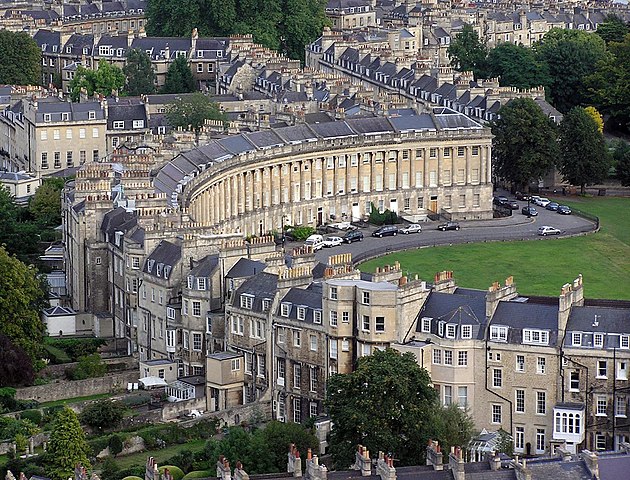Road Trip Through History: Bath

Having spent many hours enthralled by the novels of Jane Austen and Georgette Heyer, I was excited to arrive in Bath, our last stop in England. It was thrilling to have lunch in the Pump Room, to stroll through the Assembly Rooms where some of my favorite heroines danced the quadrille, and to see the neoclassical splendor of the Royal Crescent. My Own True Love and I spent a happy afternoon at the Building of Bath Museum, learning about Georgian architecture and John Wood the Elder’s development of the city into a popular Georgian resort town.*
Georgian Bath delighted me. Roman Bath blew me away.
I knew the Romans had built baths at Bath–the Romans built baths everywhere. I didn’t know that the baths at Bath were more than just baths.
When the Georgians came to drink the waters they were taking part in a centuries old tradition. Bath is home to the only thermal springs in Great Britain. Ancient Britons worshipped a goddess of the springs, Sulis, long before the Romans arrived in 43 CE. The Romans identified Sulis with their own goddess of wisdom, Minerva. The two religions merged together in a temple-bath complex at the new town of Aquae Sulis that was in use for roughly 300 years. Pilgrims came from all over the Roman empire to bathe in the springs and consult the goddess.
Today the ruins of the Roman baths and temple lie under the streets of Bath. Partially excavated, they form the heart of an excellent museum that ties together Roman history, religion, social history, urban planning, and plumbing to tell a fascinating story of the birth, death, and eventual rebirth of the city. You can even have a glass of the famous waters if you feel the need.
* We like buildings almost as much as we like history. History and buildings together? Heaven!
______________________________________________________________________________
A few travel notes for anyone inclined to worship at the goddess’s spring, take the waters, or otherwise visit Bath:
- The city of Bath sponsors free two-hour tours led by The Mayor’s Corps of Honorary Guides, a volunteer group of carefully trained local enthusiasts. My guess is that the tours differ from guide to guide. Our guide was engaging, opinionated, and passionate about his city’s history. Overheard bits of another tour suggest that the guides are uniformly excellent.
- If you’re a vegetarian–or just feeling like you’ll get scurvy if you don’t have a few vegetables soon–try Demuth’s Vegetarian Restaurant. Our meals were as inventive and elegant as anything cooked by Charlie Trotter. Honest.





I am actually heading to Bath for a day next weekend (in London for a few weeks for work). Thanks for the nice write-up! Glad to see the tour is free…
Any other advice on what to do in Bath?
Adam: Again, the tours are fabulous and so is the museum related to the Roman baths. Depending on what you’re interested in, there’s a fashion history museum, a small Jane Austen museum and a quirky museum about industry in Bath. We’re really interested in architecture, so once we had a feel for the land we really enjoyed just walking.
Have a great visit!
Pamela.
Oh how I adore Bath. I spent my time wandering along Laura Street or the Crescent, pretending I was a Heyer heroine. 🙂 I was only 18 when I went, so more into the Georgian stuff than the Roman – although I thought the Baths themselves were ok, if smelly.
My lackluster reaction was probably influenced by the sketchy dude who followed me around the whole time asking if I wanted him to take my picture. I had to hide in the bathroom for 10 minutes before he left. But such are the risks when you travel alone at age 18.
P.S. If you want modern day Bath fiction – try Peter Lovesey’s Superintendent Peter Diamond series. They’re lovely.
These days the baths themselves are in a new location that appears to be pretty luxurious. With only two days in Bath, we gave them a pass.
Adding Peter Lovesey to the list.